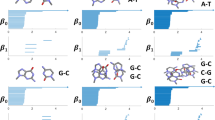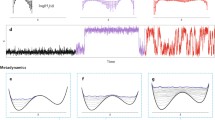Abstract
A new computational procedure which simultaneously provides gap closure and side-chain positioning in homology modelling is described. It uses a database search scheme to generate fragments to model gaps, a rotamer library to define side-chain conformations, and iteratively refines a conformational matrix CM, such that its elements CM(i,j,0) and CM(i,j,k) give the probabilities that the backbone of residue i adopts the conformation described by fragment j and that its side-chain adopts the conformation of its possible rotamer k. Each residue experiences the average of all possible environments, weighted by their respective probabilities. The method converges, thereby deserving the name of ‘self consistent mean field’ approach.
This is a preview of subscription content, access via your institution
Access options
Subscribe to this journal
Receive 12 print issues and online access
$189.00 per year
only $15.75 per issue
Buy this article
- Purchase on Springer Link
- Instant access to full article PDF
Prices may be subject to local taxes which are calculated during checkout
Similar content being viewed by others
References
Thornton, J.M., Flores, T.P., Jones, D.T. & Swindells, M.B. Prediction of progress at last. Nature 354, 105 (1991).
Benner, S.A., Predicting de novo the folded structure of proteins. Curr. Opin. struct. Biol. 2, 402–412 (1992).
Karplus, M. & Shakhnovich, E. Protein folding: theoretical studies of thermodynamics and dynamics. In Protein Folding Ed., Creighton, T.E. 127–196 (W.H. Freeman and Company, New York; 1992).
Chothia, C. & Lesk, A.M. The relation between the divergence of sequence and structure in proteins. EMBO J., 5, 823–826 (1986).
Sali, A. & Blundell, T.L. Comparative protein modelling by satisfaction of spatial restraints. J. molec. Biol. 234, 719–815 (1993).
Hubbard, T.J.P. & Blundell, T.L. Comparison of solvent inaccessible cores of homologous proteins : definitions useful for protein modelling. Prot. Engng. 1, 159–171 (1988).
Jones, T.A. & Thirup, S. Using known substructures in protein model building and crystallography. EMBO J. 5, 819–822 (1986).
Summers, N.L. & Karplus, M. Modelling of globular proteins. A distance-based search procedure for the construction of insertion/deletion regions and Pro↔nonPro mutations. J. molec. Biol. 216, 991–1016 (1990).
Moult, J. & James, M.N.G. An algorithm for determining the conformation of polypeptide segments in protein by systematic search. Proteins: Struct. Funct. Genet 1, 146–163 (1986).
Bruccoleri, R.E. & Karplus, M. Prediction of the folding of short polypeptide segments by uniform conformational sampling. Biopolymers 26, 137–168 (1987).
Go, N. & Scheraga, H.A. Ring closure and local conformational deformations of chain molecules. Macromolecules, 3, 178–187 (1970).
Bruccoleri, R.E. & Karplus, M. Chain closure with bond angle variations. Macromolecules 18, 2767 (1985).
Palmer, K.A. & Scheraga, H.A. Standard geometry chains fitted to X-ray derived structures: validation of the rigid-geometry approximation. I. Chain closure through a limited search of ‘loop’ conformations. J. comp. Chem. 12, 505–526 (1991).
Zheng, Q., Rosenfeld, R., Vajda, S. & DeLisi, C. Loop closure via bond scaling and relaxation. J. Comp. Chem. 14, 556–565 (1993).
Zheng, Q., Rosenfeld, R., DeLisi, C. & Kyle, J.D. Multiple copy sampling in protein loop modeling: computational efficiency and sensitivity to dihedral angle pertubations. Prot. Sci. 3, 493–506 (1994).
Roitberg, A. & Elber, R. Modelling side-chains in peptides and proteins: application of the locally enhanced sampling and the simulated annealing method to find minimum energy conformations. J. Chem. Phys, 95, 9277–9287 (1991).
Lee, C. & Subbiah, S. Prediction of protein side-chain conformation by packing optimisation. J. molec. Biol. 217, 373–388 (1991).
Holm, L. & Sander, C. Database algorithm for generating protein backbone and side-chain coordinates from Cα trace: application to model building and detection of co-ordinate errors. J. molec. Biol 218, 183–194 (1991).
Lee, C. Predicting protein mutant energetics by self consistent ensemble optimisation. J. molec. Biol 236, 918–939 (1994).
Koehl, P. & Delarue, M. Application of a self-consistent mean field theory to predict side-chains conformation and estimate their conformational entropy. J. molec. Biol, 239, 249–275 (1994).
Wilson, C., Gregoret, L.M. & Agard, D.A. Modelling side-chain conformation for homologous proteins using an energy-based rotamer search. J. molec. Biol 229, 996–1006 (1993).
Nilges, M. and Brünger, A.T. Automated modeling of coiled coils: application to the GCN4 dimerization region. Prot. Eng., 4, 649–659 (1991).
Eisenmenger, F., Argos, P. & Abagyan, R. A method to configure protein side-chains from the main-chain trace in homology modelling. J. molec. Biol. 231, 849–860 (1993).
Dunbrack, R.L., Jr, & Karplus, M. Backbone-dependent rotamer library for proteins : Application to side-chain prediction. J, molec. Biol. 230, 543–571 (1993).
Tuffery, P., Etchebest, C., Hazout, S. & Lavery, R. A new approach to the rapid determination of protein side-chain conformation. J. biomolec. Struct. Dynam. 8, 1267–1289 (1991).
Desmet, J., DeMaeyer, M., Hazes, B. & Lasters, I. The deadend elimination theorem and its use in protein side-chain positioning. Nature 356, 539–542 (1992).
Lasters, I. & Desmet, J. The fuzzy-end elimination theorem : correctly implementing the side-chain placement algorithm based on the dead-end elimination theorem. Prot. Engng. 6, 717–722 (1993).
Elber, R. & Karplus, M. Enhanced sampling in molecular dynamics : use of the time-dependent Hartree approximation for a simulation of carbon monoxide diffusion through myoglobin. J. Am. chem. Soc 112, 9161–9175 (1990).
Czerminski, R. & Elber, R. Computational studies of ligand diffusion in globins : I Leghemoglobin. Proteins Struct. Funct. Genet., 10, 70–80 (1991).
Caflish, A., Miranker, A. & Karplus, M. Multiple copy simultaneous search and construction of ligands in binding sites: Application, to inhibitors of HIV-1 aspartic proteinase. J. med. Chem. 36, 2142–2164 (1993).
Finkelstein, A.V. & Reva, B.A. A search for the most stable folds of protein chains. Nature 351, 497–499 (1991).
Rabow, A. A. & Scheraga, H.A. Lattice neural network optimization for locating the global minimum conformations of proteins. J. molec. Biol. 232, 1157–1168 (1993).
Fidelis, K., Stern, P.S., Bacon, D. & Moult, J. Comparison of systematic search and database methods for constructing segments of protein structure. Prot. Engng 7, 953–960 (1994).
Berstein, F.C. et al. The protein databank: a computer-based archival file for macromolecular structures. J. molec. Biol., 112, 535–542 (1977).
Devereux, J., Haeberli, P. & Smithies, O. A comprehensive set of sequence analysis programs for the VAX. Nucleic. Acids Res. 12, 387–395 (1984).
Summers, N.L. & Karplus, M. Modelling of side-chains, loops, and insertions in proteins. Meths Enzymol. 202, 156–204 (1991).
Dunbrack, R.L., Jr . & Karplus, M. Conformational analysis of the backbone-dependent rotamer preferences of protein sidechains. Nature struct. Biol. 1, 334–340 (1994).
Koehl, P. & Delarue, M. Polar and non polar atomic environments in the protein core : implications for folding and binding. Proteins Struct. Funct. Genet. 20, 264–278 (1994).
Brooks, III, C.L., Bruccoleri, R.E., Olafson, B.P., States, D.J., Swaminathan, S. & Karplus, M. CHARMM : a program for macromolecular energy minimization and dynamics calculations. J. comp. Chem., 4, 187–217 (1983).
Brunger, A.T. & Karplus, M. Polar hydrogen positions in proteins: empirical energy placement and neutron diffraction comparison. Proteins Struct. Funct. Genet, 4, 148–156 (1988).
Author information
Authors and Affiliations
Rights and permissions
About this article
Cite this article
Koehl, P., Delarue, M. A self consistent mean field approach to simultaneous gap closure and side-chain positioning in homology modelling. Nat Struct Mol Biol 2, 163–170 (1995). https://doi.org/10.1038/nsb0295-163
Received:
Accepted:
Issue Date:
DOI: https://doi.org/10.1038/nsb0295-163
This article is cited by
-
The H-factor as a novel quality metric for homology modeling
Journal of Clinical Bioinformatics (2012)
-
A quality metric for homology modeling: the H-factor
BMC Bioinformatics (2011)
-
MOLS sampling and its applications in structural biophysics
Biophysical Reviews (2010)



